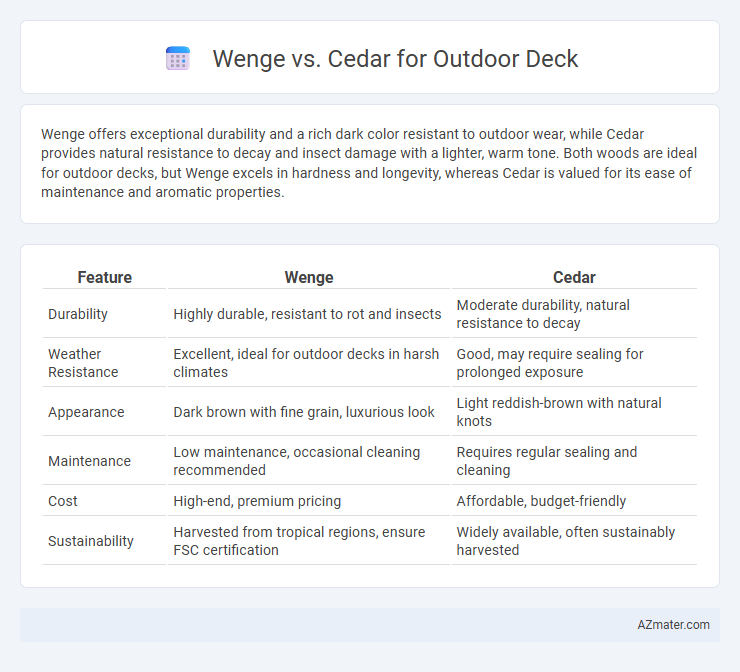Wenge offers exceptional durability and a rich dark color resistant to outdoor wear, while Cedar provides natural resistance to decay and insect damage with a lighter, warm tone. Both woods are ideal for outdoor decks, but Wenge excels in hardness and longevity, whereas Cedar is valued for its ease of maintenance and aromatic properties.
Table of Comparison
| Feature | Wenge | Cedar |
|---|---|---|
| Durability | Highly durable, resistant to rot and insects | Moderate durability, natural resistance to decay |
| Weather Resistance | Excellent, ideal for outdoor decks in harsh climates | Good, may require sealing for prolonged exposure |
| Appearance | Dark brown with fine grain, luxurious look | Light reddish-brown with natural knots |
| Maintenance | Low maintenance, occasional cleaning recommended | Requires regular sealing and cleaning |
| Cost | High-end, premium pricing | Affordable, budget-friendly |
| Sustainability | Harvested from tropical regions, ensure FSC certification | Widely available, often sustainably harvested |
Introduction to Wenge and Cedar for Outdoor Decks
Wenge is a dense, dark hardwood known for its durability and resistance to decay, making it an excellent choice for outdoor decks exposed to harsh weather. Cedar offers natural resistance to insects and moisture with a lighter, warm appearance, providing a balance of strength and aesthetic appeal. Both woods enhance outdoor spaces but differ in maintenance requirements and color longevity.
Key Characteristics of Wenge Wood
Wenge wood is prized for its exceptional durability and deep, rich brown color with dark veining, making it an attractive choice for outdoor decks that require a striking appearance and resistance to decay. Its high density and natural resistance to insects and moisture contribute to a long-lasting, low-maintenance decking surface that performs well in various weather conditions. Compared to cedar, which is softer and lighter with a more pronounced aroma, Wenge offers superior hardness and a more refined, exotic aesthetic that enhances outdoor living spaces.
Key Characteristics of Cedar Wood
Cedar wood features natural resistance to decay and insect damage, making it a durable choice for outdoor decking. Its straight grain and fine texture provide a smooth surface that is easy to work with and finish. Cedar's lightweight nature and ability to retain stability in varying weather conditions contribute to its popularity for sustainable and low-maintenance outdoor decks.
Durability and Weather Resistance Comparison
Wenge hardwood offers exceptional durability with a Janka hardness rating of approximately 1630, making it highly resistant to dents and scratches in outdoor decking applications. Cedar, while softer with a Janka rating around 350, excels in natural weather resistance due to its high tannin content that protects against decay, insects, and moisture. Both woods require proper sealing, but Wenge's dense grain structure provides superior longevity and resistance to warping under extreme weather conditions compared to cedar.
Maintenance Requirements: Wenge vs Cedar
Wenge decks require minimal maintenance due to their natural oils, which resist moisture and insect damage, reducing the need for frequent sealing or staining. Cedar decks, while naturally resistant to decay and insects, demand more regular upkeep, including yearly sealing and occasional sanding to prevent weathering and maintain their appearance. Choosing Wenge offers a durable, low-maintenance solution for outdoor decking, whereas cedar requires consistent care to preserve its longevity and aesthetic appeal.
Aesthetic Differences: Color and Grain Patterns
Wenge wood features a deep, rich chocolate-brown color with subtle black streaks, creating a bold and exotic appearance that darkens with age. Cedar exhibits a lighter, reddish-brown to pinkish hue with a more pronounced, straight grain pattern that offers a warm, natural look. The contrast in color and grain patterns between Wenge's dense, dramatic texture and Cedar's softer, more uniform lines influences the overall aesthetic of outdoor decks significantly.
Environmental Impact and Sustainability
Wenge wood, sourced mainly from Central and West Africa, poses significant sustainability challenges due to its slow growth rate and high demand, leading to concerns about deforestation and habitat loss. Cedar, particularly Western Red Cedar from North America, is often regarded as a more sustainable choice because it is renewable, grows relatively quickly, and is commonly harvested from well-managed forests certified by organizations like the FSC. Choosing cedar over wenge for outdoor decking reduces environmental impact by supporting responsible forestry practices and promoting the use of more abundant, renewable timber resources.
Cost Analysis: Wenge vs Cedar Decks
Wenge decks typically cost between $20 and $30 per square foot due to their exotic hardwood status and durability, whereas cedar decks range from $15 to $25 per square foot, offering a more budget-friendly option. Despite the higher initial investment, Wenge requires less maintenance and has a longer lifespan, potentially lowering long-term expenses compared to cedar, which is prone to rot and insect damage. Factoring in maintenance and replacement costs, Wenge often presents better overall value for outdoor decking in terms of durability and lifecycle cost efficiency.
Installation and Workability
Wenge offers a dense, hard texture that makes installation more challenging due to its resistance to cutting and fastening, requiring sharp tools and pre-drilling for screws. Cedar is softer and lighter, allowing for easier handling, cutting, and nailing, which speeds up the installation process and minimizes tool wear. Both woods are dimensionally stable outdoors, but cedar's superior workability makes it a preferred option for DIY deck projects.
Choosing the Right Wood: Wenge or Cedar for Your Deck
Wenge offers exceptional durability and a rich, dark finish that resists rot and insects, making it ideal for outdoor decks requiring long-lasting strength and low maintenance. Cedar features a naturally aromatic, reddish hue with excellent resistance to decay and a lightweight structure that simplifies installation and upkeep in outdoor environments. Selecting between Wenge and Cedar depends on desired aesthetics, budget constraints, and specific climate conditions impacting wood performance and longevity.

Infographic: Wenge vs Cedar for Outdoor Deck
 azmater.com
azmater.com